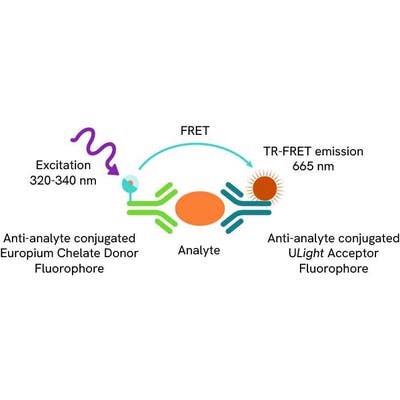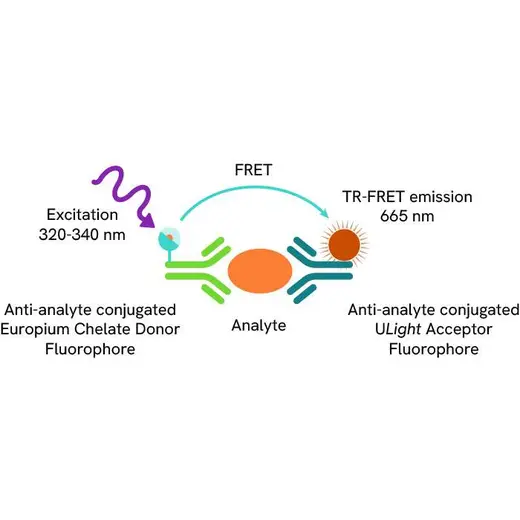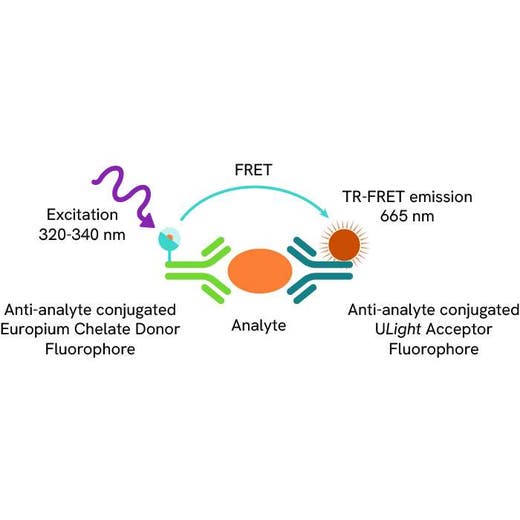
LANCE Ultra Human PCSK9 Detection Kit, 10,000 Assay Points

LANCE Ultra Human PCSK9 Detection Kit, 10,000 Assay Points




The LANCE® Ultra Human PCSK9 Detection Kit is designed for detection and quantitation of human Proprotein Convertase Subtilisin/Kexin Type 9 in cell culture media using a homogeneous TR-FRET (no-wash steps, no separation steps) assay.
For research use only. Not for use in diagnostic procedures. All products to be used in accordance with applicable laws and regulations including without limitation, consumption and disposal requirements under European REACH regulations (EC 1907/2006).
| Feature | Specification |
|---|---|
| Application | Protein Quantification |
| Dynamic Range | 42.6 - 100,000 pg/mL |
| Limit of Detection | 42.6 pg/mL |
| Limit of Quantification | 223.2 pg/mL |
| Sample Volume | 15 µL |
The LANCE® Ultra Human PCSK9 Detection Kit is designed for detection and quantitation of human Proprotein Convertase Subtilisin/Kexin Type 9 in cell culture media using a homogeneous TR-FRET (no-wash steps, no separation steps) assay.
For research use only. Not for use in diagnostic procedures. All products to be used in accordance with applicable laws and regulations including without limitation, consumption and disposal requirements under European REACH regulations (EC 1907/2006).


LANCE Ultra Human PCSK9 Detection Kit, 10,000 Assay Points


LANCE Ultra Human PCSK9 Detection Kit, 10,000 Assay Points


Product information
Overview
The LANCE Ultra Human PCSK9 Detection Kit is designed for detection and quantitation of human PCSK9 in cell culture media using a homogeneous TR-FRET (no-wash steps, no separation steps) assay.
- No-wash steps, no separation steps
- TR-FRET technology
- Sensitive detection
- High reproducibility
- Faster time-to-results
- Easy automation
- 96-well, 384-well, and 1536-well formats
LANCE and LANCE (Lanthanide chelate excite) Ultra are our TR-FRET (time-resolved fluorescence resonance energy transfer), homogeneous (no wash) technologies. One antibody of interest is labeled with a donor fluorophore (a LANCE Europium chelate) and the second molecule is labeled with an acceptor fluorophore (ULight™ dye). Upon excitation at 320 or 340 nm, energy can be transferred from the donor Europium chelate to the acceptor fluorophore if sufficiently close for FRET (~10 nm). This results in the emission of light at 665 nm.
Human Proprotein Convertase Subtilisin / Kexin Type 9 (PCSK9) belongs to the proteinase K subfamily of the secretory subtilase family. This glycoprotein contains 692 amino acids, including a signal peptide, a prodomain, and a catalytic domain. Initially synthesized as a soluble 74 kDa precursor protein, it is cleaved into 14 kDa and 60 kDa domains, which remain associated. This protein plays a major regulatory role in cholesterol homeostasis and is highly expressed in the kidney, liver, and intestine. PCSK9 binds to the low-density lipoprotein receptor (LDLR), inducing LDLR degradation. Reduced LDLR levels result in decreased metabolism of low-density lipoprotein, which could lead to hypercholesterolemia. Inhibition of PCSK9 function is currently being explored as a means of lowering cholesterol levels. Mutations in this gene have been associated with a rare form of autosomal dominant familial hypercholesterolemia.
Specifications
| Application |
Protein Quantification
|
|---|---|
| Automation Compatible |
Yes
|
| Brand |
LANCE Ultra
|
| Detection Modality |
LANCE
|
| Dynamic Range |
42.6 - 100,000 pg/mL
|
| Limit of Detection |
42.6 pg/mL
|
| Limit of Quantification |
223.2 pg/mL
|
| Product Group |
Kit
|
| Sample Volume |
15 µL
|
| Shipping Conditions |
Shipped in Blue Ice
|
| Target |
PCSK9
|
| Target Class |
Biomarkers
|
| Target Species |
Human
|
| Technology |
TR-FRET
|
| Therapeutic Area |
Metabolic
|
| Unit Size |
10,000 Assay Points
|
Resources
Are you looking for resources, click on the resource type to explore further.
LANCE™ Ultra TR-FRET is a no-wash proximity assay technology that combines the benefits of time resolution (TR) with fluorescence...


How can we help you?
We are here to answer your questions.






























